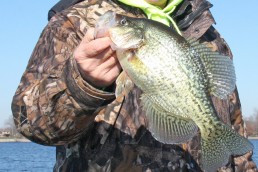Up Your Odds for Your Biggest Crappie Ever
SHARE THIS POST
When trying to catch monster crappies, good planning presentation and a lot of luck are usually involved, but Tim Huffman has a few tips to up the odds in your favor.
Equipment is a fisherman-controlled factor. The first step is to have the right equipment for the job. For example, don’t be jigging shallow cover with a 6- or 7-foot spinning rod when a 10- to 12-foot jigging pole should be used. It’s okay to have multi-purpose equipment providing it does the job. Low- to medium-priced tackle will do great for catching crappies.
Check everything before each trip including rods, reels and line. Bad line and knots are the two primary tackle causes for lost fish. Change line periodically, check it often and re-tie knots regularly.
Fish the right season. This is a tough one because different regions have different peak times. However, winter crappies are usually very healthy, are growing and are predictable. So, January and February are good months, whether under the ice or in open water.
The spawn in Mississippi starts in March. Reelfoot, Tennessee and Kentucky Lake often have April spawns. Northern states often have May spawns, or maybe a little later. Weather patterns relate to water temperatures, so each year can be different. A key time for big fish in each region is the three or four weeks before spawn. The females are active and full of eggs. They weigh the most they will weigh all year. The males are thick and heavy, unlike what they’ll be after the spawn.
Another advantage of pre-spawn is fish pattern consistency. Crappies are predictable before they scatter to the banks. Even then, not all fish spawn at the same time, so both spawners and pre-spawners can be caught.
Quiet and stealth are critical. Fishermen say they catch fish while talking, listening to the radio and slamming livewell lids. That can happen, especially when catching smaller crappies. But, like a big buck deer gets smarter and more difficult to harvest, so do larger fish. They recognize trolling motor and transducer sounds. They are particularly spooky of something dropped in the bottom of the boat or a lid slammed.
Be mentally prepared. One of the most difficult things for a weekend fishermen to do is stay focused. It’s not easy to pay attention when it’s been an hour since the last bite. However, by focusing and expecting the next bite to be a big whopper, the odds of catching it dramatically increase.
Are you enjoying this post?
You can be among the first to get the latest info on where to go, what to use and how to use it!
Fish the right areas. Most lakes have areas where more big fish are caught. Every lake is different, but asking questions and doing research can help find general areas to increase your odds.
Fish a pattern. Don’t get hung up on just fishing spots. Look for patterns. When fish aren’t where a fisherman expects them to be located, it’s time to search different depths and structures to learn their preference. Learning a pattern usually means crappies can be caught in similar places in the lake.
Hooking and landing are both essential to catching a big crappie. A hookset on a fish 20 feet deep is different with a medium-action 7-foot rod with fluorocarbon line compared to a 10-foot limber pole with monofilament. In general, a very firm hookset is needed to catch a big fish. A small crappie requires only slight pressure, but a big crappie has an extremely tough, bony upper lip that requires a hard hookset to penetrate. Experience can be a tough teacher, but the more fish a person catches, the better the hookset will become.
Huge numbers of fish are lost each year because of slack line. Setting the hook and then dropping the rod tip, or trying to maneuver a fish to a net, are critical times to keep some pressure on the line.
Using a net is important. The correct procedure is to bring the fish to the top of the water within reach of the net. Net the fish immediately as it gets to the surface.
Fish big-fish waters. “You can’t catch what’s not there.” You must go to a lake with big fish. That might be a lake with pound-and-a-half or two-pound crappies. Most fishermen consider anything over two pounds a very good fish. If a fisherman is serious about catching a monster, plan a dream trip to Mississippi where chances of 3-pound crappies are possible.
When it comes to fishing, are you ready to try something new? Look for inspiration in the winter issues of MidWest Outdoors, available by subscribing on our website.
MWO
SHARE THIS POST
You may also like...
Nothing found.
Did you enjoy this post?
You can be among the first to get the latest info on where to go, what to use and how to use it!
Tim Huffman
Tim Huffman specializes in crappie fishing, is editor for two crappie magazines, as well as writing for several others. In 2018, he published his sixth book, Limiting Out for Crappie, available at Amazon. His first article appeared in MidWest Outdoors in 1988.
